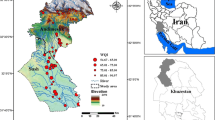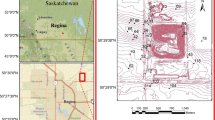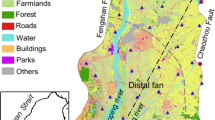Abstract
Mapping groundwater contaminants and identifying the sources are the initial steps in pollution control and mitigation. Due to the availability of different mapping methods and the large number of emerging pollutants, these methods need to be used together in decision making. The present study aims to map the contaminated areas in Richards Bay, South Africa and compare the results of ordinary kriging (OK) and inverse distance weighted (IDW) interpolation techniques. Statistical methods were also used for identifying contamination sources. Na–Cl groundwater type was dominant followed by Ca–Mg–Cl. Data analysis indicate that silicate weathering, ion exchange and fresh water–seawater mixing are the major geochemical processes controlling the presence of major ions in groundwater. Factor analysis also helped to confirm the results. Overlay analysis by OK and IDW gave different results. Areas where groundwater was unsuitable as a drinking source were 419 and 116 km2 for OK and IDW, respectively. Such diverse results make decision making difficult, if only one method was to be used. Three highly contaminated zones within the study area were more accurately identified by OK. If large areas are identified as being contaminated such as by IDW in this study, the mitigation measures will be expensive. If these areas were underestimated, then even though management measures are taken, it will not be effective for a longer time. Use of multiple techniques like this study will help to avoid taking harsh decisions. Overall, the groundwater quality in this area was poor, and it is essential to identify alternate drinking water source or treat the groundwater before ingestion.













Similar content being viewed by others
References
Aller L, Bennet T, Lehr JH and Petty RJ (1985) DRASTIC: a standardized system for evaluating ground water pollution potential using hydrogeological settings. R.S. Kerr, Envir. Res. Lab., EPA/600/2-85/018, Ada, Oklahoma
Anane M, Abidi B, Lachaal F, Limam A, Jellali S (2013) GIS-based DRASTIC, pesticide DRASTIC and the susceptibility index (SI): comparative study for evaluation of low pollution potential in the Nabeul-Hammamet shallow aquifer, Tunisia. Hydrogeology J 21(3):715–731
APHA (American Public Health Association) (1998) Standard methods for the examination of water and wastewater, 20th edn. American Public Health Association/American Water Works Association/Water Environment Federation, Washington DC
Appelo CAJ, Postma D (1993) Geochemistry, groundwater and pollution, 2nd edn. Balkema, Rotterdam, p 321
Arslan H (2013) Application of multivariate statistical techniques in the assessment of groundwater quality in seawater intrusion area in Bafra Plain, Turkey. Environ Monit Assess 185(3):2439–2452
Bhardwaj V, Singh DS (2011) Surface and groundwater quality characterization of Deoria District, Ganga Plain. India Environ Earth Sci 63(2):383–395
Bouzourra H, Bouhlila R, Elango L, Slama F, Ouslati N (2015) Characterization of mechanisms and processes of groundwater salinization in irrigated coastal area using statistics, GIS and hydrogeochemical investigations. Environ Sci Pollut Res 22(4):2643–2660
Brindha K, Elango L (2012a) Impact of tanning industries on groundwater quality near a metropolitan city in India. Water Resour Manag 26(6):1747–1761
Brindha K, Elango L (2012b) Groundwater quality zonation in a shallow weathered rock aquifer using GIS. Geo-spatial Information Science 15(2):95–104
Brindha K, Elango L (2015) Cross comparison of five popular groundwater pollution vulnerability index approaches. J Hydrol 524:597–613
Brindha K, Neena Vaman KV, Srinivasan K, Sathis Babu M, Elango L (2014) Identification of surface water–groundwater interaction by hydrogeochemical indicators and assessing the suitability for drinking and irrigational purposes in Chennai, southern India. Appl Water Sci 4(2):159–174
Brindha K, Pavelic P, Sotoukee T, Douangsavanh S, Elango L (2016) Geochemical characteristics and groundwater quality in the Vientiane Plain, Laos. Exposure and Health. doi:10.1007/s12403-016-0224-8
Buchanan S, Triantafilis J (2009) Mapping water table depth using geophysical and environmental variables. Ground Water 47:80–96
Chen L, Feng Q (2013) Geostatistical analysis of temporal and spatial variations in groundwater levels and quality in the Minqin oasis, Northwest China. Environ Earth Sci 70:1367–1378
Chester R, Jickells TD (2012) Marine geochemistry. Blackwell Publishing, Oxford
Chiras DD (2001) Environmental science: creating a sustainable future, 6th edn. Jones and Bartlett Publishers, Inc, p 731
Chung SY, Venkatramanan S, Park N, Rajesh R, Ramkumar T, Kim BW (2015) An assessment of selected hydrochemical parameter trend of the Nakdong River water in South Korea, using time series analyses and PCA. Environ Monit Assess 187:4192
Doneen LD (1964) Water quality for agriculture. Department of Irrigation, University of California, Davis
DWAF (Department of water affairs and forestry) (1996) South African water quality guidelines (second edition). Volume 1: domestic use., Pretoria. Pp. 214
DWAF (2000) Strategic environmental assessment for water use Mhlathuze catchment—KZN. Report No SEA-01/2000
Eaton EM (1950) Significance of carbonates in irrigation waters. Soil Sci 69:123–133
ESRI (2012) ArcGIS desktop: release 10. Environmental Systems Research Institute, Redlands, CA
Falivene O, Cabrera L, Sáez A (2007) Optimum and robust 3D facies interpolation strategies in a heterogeneous coal zone (tertiary as Pontes Basin, NW Spain). Int J Coal Geol 71:185–208
Falivene O, Cabrera L, Tolosana-Delgado R, Sáez A (2010) Interpolation algorithm ranking using cross-validation and the role of smoothing effect. A coal zone example. Comput Geosci 36:512–519
Freeze RA, Cherry JA (1979) Groundwater. Prentice Hall Inc, New Jersey
Germishuyse, T. (1999) A geohydrological study of the Richards bay area. Master of Science thesis. Department f Hydrology, University of Zululand
Gong G, Mattevada S, O’Bryant SE (2014) Comparison of the accuracy of kriging and IDW interpolations in estimating groundwater arsenic concentrations in Texas. Environ Res 130:59–69
Gorai AK, Hasni SA, Iqbal J (2014) Prediction of ground water quality index to assess suitability for drinking purposes using fuzzy rule-based approach. Appl Water Sci DOI. doi:10.1007/s13201-014-0241-3
Gundogdu KS, Guney I (2007) Spatial analyses of groundwater levels using universal kriging. Journal of Earth Systems Science 116(1):49–55
Helena B, Pardo R, Vega M, Barrado E, Fernandez JM, Fernandez L (2000) Temporal evolution of groundwater composition in an alluvial aquifer (Pisuerga river, Spain) by principal component analysis. Water Res 34:807–816
Horton RK (1965) An index number system for rating water quality. J Water Pollut Control Fed 37(3):300–306
IBM SPSS (International Business Machines Corporation Statistical Package for the Social Sciences) (2013) IBM SPSS statistics for Windows, version 22.0. IBM Corp, Armonk
Jankowski J, Acworth RI and Shekarforoush S (1998) Reverse ion exchange in a deeply weathered porphyritic dacite fractured aquifer system, Yass, New South Wales, Australia. In Arehart GB, & Hulston JR (Eds.), In Proceedings of the 9th International Symposium, water–rock interaction (pp 243–246). Rotterdam: Balkema
Jones BF, Vengosh A, Rosenthal E, Yechieli Y (1999) Geochemical investigations. Chapter 3. In: Bear J, Sorek S, Ouazar D, Herrera I (eds) Seawater intrusion in coastal aquifers—concepts, methods and practises. Kluwer Academic Publishers, Dordrecht, pp 51–72
Journel AG, Huijbregts CH (1978) Mining geostatistics. Academic, Cambridge
Kelbe B, Germishuyse T, Snyman N, Fourie I (2001) Geohydrological studies of the primary coastal aquifer in Zululand. WRC report no.720/1/01. Water Research Commission, Pretoria
Kelly WP (1957) Adsorbed sodium cation exchange capacity and percentage sodium sorption in alkali soils. Science 84:473–477
Kim J-H, Kim R-H, Lee J, Cheong T-J, Yum B-W, Chang H-W (2005) Multivariate statistical analysis to identify the major factors governing groundwater quality in the coastal area of Kimje, South Korea. Hydrol Process 19:1261–1276. doi:10.1002/hyp.5565
Kumar PJS, Elango L, James EJ (2014) Assessment of hydrochemistry and groundwater quality in the coastal area of South Chennai, India. Arab J Geosci 7(7):2641–2653
Li P, Li X, Meng X, Li M, Zhang Y (2016) Appraising groundwater quality and health risks from contamination in a semiarid region of northwest China. Exposure and Health 8(3):361–379. doi:10.1007/s12403-016-0205-y
Li P, Qian H, Wu J (2010) Groundwater quality assessment based on improved water quality index in Pengyang County, Ningxia, Northwest China. E-Journal of Chemistry 7(S1):S209–S216. doi:10.1155/2010/451304
Li P, Qian H, Wu J (2011) Application of set pair analysis method based on entropy weight in groundwater quality assessment-a case study in Dongsheng City, Northwest China. E-Journal of Chemistry 8(2):851–858. doi:10.1155/2011/879683
Li P, Qian H, Wu J (2014) Origin and assessment of groundwater pollution and associated health risk: a case study in an industrial park, northwest China. Environ Geochem Health 36(4):693–712. doi:10.1007/s10653-013-9590-3
Li P, Wu J, Qian H (2012) Groundwater quality assessment based on rough sets attribute reduction and TOPSIS method in a semi-arid area, China. Environ Monit Assess 184(8):4841–4854. doi:10.1007/s10661-011-2306-1
Lloyd JW, Heathcote JA (1985) Natural inorganic hydrochemistry in relation to groundwater. Clarendon Press, Oxford
Machiwal D, Jha MK (2015) Identifying sources of groundwater contamination in a hard-rock aquifer system using multivariate statistical analyses and GIS-based geostatistical modeling techniques. Journal of Hydrology: Regional Studies 4:80–110
Machiwal D, Singh PK (2015) Understanding factors influencing groundwater levels in hard-rock aquifer systems by using multivariate statistical techniques. Environ Earth Sci 74:5639–5652
Mirzaei R, Sakizadeh M (2016) Comparison of interpolation methods for the estimation of groundwater contamination in Andimeshk-Shush Plain, Southwest of Iran. Environ Sci Pollut Res 23:2758–2769
Mondal NC, Singh VP (2011) Hydrochemical analysis of salinization for a tannery belt in Southern India. J Hydrol 405:235–247
Mouser PJ, Rizzo DM, Röling WF, Van Breukelen BM (2005) A multivariate statistical approach to spatial representation of groundwater contamination using hydrochemistry and microbial community profiles. Environ Sci Technol 39(19):7551–7559
Mueller TG, Pierce FJ, Schabenberger O, Warncke DD (2001) Map quality for site-specific fertility management. Soil Sci Soc Am J 65(5):1547–1558
Park S, Yun S, Chae G, Yoo I, Shin K, Heo C, Lee S (2005) Regional hydrochemical study on salinization of coastal aquifers, western coastal area of South Korea. J Hydrol 313:182–194
Qian H, Li P, Howard KWF, Yang C, Zhang X (2012) Assessment of groundwater vulnerability in the Yinchuan Plain, Northwest China using OREADIC. Environ Monit Assess 184(6):3613–3628
Rajesh R, Brindha K, Murugan R, Elango L (2012) Influence of hydrogeochemical processes on temporal changes in groundwater quality in a part of Nalgonda district, Andhra Pradesh India. Environ Earth Sci 65:1203–1213
Richards LA (1954) Diagnosis and improvement of saline and alkali soils. USDA handbook 60
Richter BC and Kreitler CW (1993) Geochemical techniques for identifying sources of ground-water salinization. Boca Raton, Florida: C.R.C. Press, Inc.
Sawyer CN, McCarty PL (1978) Chemistry of environmental engineering. In: Series in water resources and environmental engineering, 3rd edn. McGraw–Hill, NY
Schulze RE (1982) Agrohydrology and climatology of Natal. Published by Water Research Commission, Pretoria
Shepard D (1968) A two-dimensional interpolation function for irregularly-spaced data. Proceedings of the 1968 ACM National Conference. pp. 517–524
Shrestha S, Kazama F (2007) Assessment of surface water quality using multivariate statistical techniques: a case study of the Fuji river basin, Japan. Environ Model Softw 22:464–475
Simmonds ALE (1990) Investigations into possible saline intrusion at lake Mzingazi, Richards Bay, Department of Water Affairs, Geohydrology Report no. 3711
Spokas K, Graff C, Morcet M, Aran C (2003) Implications of the spatial variability of landfill emission rates on geospatial analyses. Waste Manag 23:599–607
Srivastava SK, Ramanathan AL (2008) Geochemical assessment of groundwater quality in vicinity of Bhalswa landfill, Delhi, India, using graphical and multivariate statistical methods. Environ Geol 53(7):1509–1528
Stallard RF, Edmond JM (1983) Geochemistry of the Amazon: 2. The influence of geology and weathering environment on the dissolved load. J Geophy Res 88:9671–9688
Stigter TY, Ribeiro L, Dill AMMC (2006) Evaluation of an intrinsic and a specific vulnerability assessment method in comparison with groundwater salinisation and nitrate contamination levels in two agricultural regions in the south of Portugal. Hydrogeol J 14:79–99
Szabolcs I and Darab C (1964) The influence of irrigation water of high sodium carbonate content of soils, Proceedings of 8th ISSS, Trans vol II 802–812
Turekian KK (1968) Oceans. Prentice-Hall, Englewood, Cliffs, N.J
Venkatramanan S, Chung SY, Kim TH, Kim B-W, Selvam S (2016) Geostatistical techniques to evaluate groundwater contamination and its sources in Miryang City, Korea. Environ Earth Sci 75:994. doi:10.1007/s12665-016-5813-0
Venkatramanan S, Chung SY, Rajesh R, Lee SY, Ramkumar T, Prasanna MV (2015) Comprehensive studies of hydrogeochemical processes and quality status of groundwater with tools of cluster, grouping analysis, and fuzzy set method using GIS platform: a case study of Dalcheon in Ulsan City, Korea. Environ Sci Pollut Res 22(15):11209–11223
Vetrimurugan E, Elango L, Rajmohan N (2013) Sources of contaminants and groundwater quality in thecoastal part of a river delta. Int. J. Environ. Sci. Technol. 10:473–486
WHO (World Health Organisation) (1993) Guidelines for drinking water quality, vol 1, 2nd edn, Recommendations, WHO, Geneva, p 130
Wilcox LV (1955) Classification and use of irrigation waters. USDA, Washington, DC Circular 969
Wu J, Li P, Qian H, Duan Z, Zhang X (2014) Using correlation and multivariate statistical analysis to identify hydrogeochemical processes affecting the major ion chemistry of waters: case study in Laoheba phosphorite mine in Sichuan, China. Arab J Geosci 7(10):3973–3982
Xie Y, Chen T-B, Lei M, Yang J, Guo Q-J, Song B, Zhou X-Y (2011) Spatial distribution of soil heavy metal pollution estimated by different interpolation methods: accuracy and uncertainty analysis. Chemosphere 82:468–476
Acknowledgements
Authors from the University of Zululand thank their University’s Department of Research and Innovation for financial assistance (Grant S721/15), the Department of Agriculture for assitance in chemical analysis and the Department of Hydrology for their extended support in successful completion of this work.
Author information
Authors and Affiliations
Corresponding author
Additional information
Responsible editor: Philippe Garrigues
Rights and permissions
About this article
Cite this article
Elumalai, V., Brindha, K., Sithole, B. et al. Spatial interpolation methods and geostatistics for mapping groundwater contamination in a coastal area. Environ Sci Pollut Res 24, 11601–11617 (2017). https://doi.org/10.1007/s11356-017-8681-6
Received:
Accepted:
Published:
Issue Date:
DOI: https://doi.org/10.1007/s11356-017-8681-6




